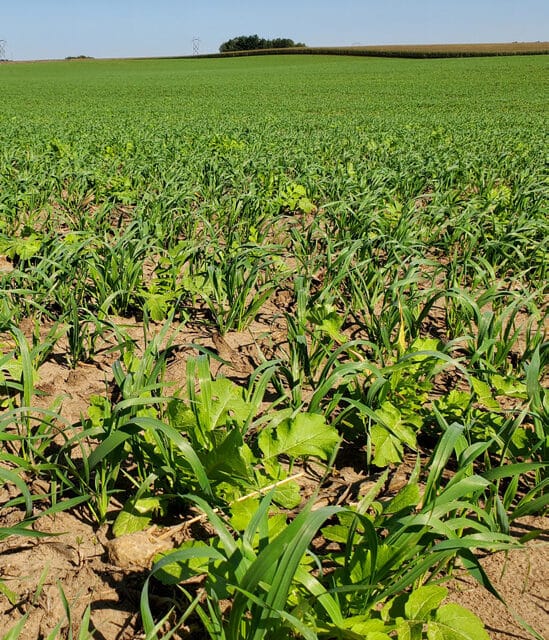NRCS, Plant Materials Program
May 2020
Source link here.


Matt Ruark – University of Wisconsin
February 2021

Midwest Cover Crops Council (MCCC-126)
This publication is intended to provide a starting point for farmers who are new to growing cover crops. With experience, farmers may fine-tune the use of cover crops for their systems.
A canning or processing crop such as green bean, sweet corn, or pea is harvested early or by midsummer and offers an excellent window to get adequate cover crop growth before any following crop. Cover crops following canning crops will protect soil from erosion and improve soil structure after heavy harvesting equipment is used to take off the canning crop. Some canning crops leave significant residual nitrogen (N) in the soil that is vulnerable to leaching, and a cover crop can retain that soil N for future crops. Since growers follow canning crops with any number of different rotations, a fast-growing species such as oats mixed with a light seeding of radish is a safe choice as both will winter-kill. With this combination, no spring termination is needed, and there is little chance of tying up N for the following year.


University of Minnesota Extension Cover Crop website
Cover Crop Selector Tool —available from Midwest Cover Crops Council
Minnesota NRCS Resources, including Minnesota Cover Crop Design Tool
USDA-NRCS Cover Crop Termination Guidelines
Using Herbicides and Cover Crops in Corn and Soybean (University of Minnesota Extension)
Anna Cates, University of Minnesota Extension; Ashley Gallagher, Dakota Soil and Water Conservation District (Minnesota); Steve Lawler, Mower Soil and Water Conservation District (Minnesota); and Matt Ruark, University of Wisconsin–Madison Division of Extension
Carl Rosen, University of Minnesota; Ken Schroeder and Dan Smith, University of Wisconsin–Madison Division of Extension; and Carissa Spencer, Minnesota NRCS
March 2021
The U.S. Department of Agriculture (USDA) prohibits discrimination in all its programs and activities on the basis of race, color, national origin, age, disability, and where applicable, sex, marital status, familial status, parental status, religion, sexual orientation, genetic information, political beliefs, reprisal, or because all or a part of an individual’s income is derived from any public assistance program. (Not all prohibited bases apply to all programs.) Persons with disabilities who require alternative means for communication of program information (Braille, large print, audiotape, etc.) should contact USDA’s TARGET Center at (202) 720-2600 (voice and TDD). To file a complaint of discrimination write to USDA, Director, Office of Civil Rights, 1400 Independence Avenue, S.W., Washington, D.C. 20250-9410 or call (800) 795-3272 (voice) or (202) 720-6382 (TDD). USDA is an equal opportunity provider and employer. ©2021 by MCCC. All rights reserved.

Eric Lee-Mader, Anne Stine, Jarrod Fowler, Jennifer Hopwood and Mace Vaughanby – Xerces Society for Invertebrate Conservation with contributions from the USDA Natural Resources Conservation Service
August 2017


University of Wisconsin, Nutrient and Pest Management Program
Cover Crop Termination Options
Source link here.

Daniel Smith, Matt Ruark, Shawn Conley – University of Wisconsin-Madison and University of Wisconsin Extension
August 2017
Herbicide Considerations for Cover Crop Establishment
Source link here.

Collaboration of MCCC Board of Directors
May 2020
Cover Crop Termination Guidelines for Unfavorable Spring Weather Conditions
Matt Ruark – University of Wisconsin
February 2020
Midwest Cover Crops Council (MCCC-119)
This publication is intended to provide a starting point for farmers who are new to growing cover crops. With experience, farmers may fine-tune the use of cover crops for their systems.
The following recipe provides an introductory approach to integrating a cover crop into a corn silage-soybean rotation.

Cover Crop Selector Tool —available from Midwest Cover Crops Council
Cover Crops 101 (University of Wisconsin–Madison Extension publication A4176)
Herbicide Rotational Restrictions for Cover and Forage Cropping Systems (University of Wisconsin–Madison Nutrient and Pest Management publication)
NRCS Cover Crop Termination Guidelines (version 4, June 2019)—available from the USDA–National Resources Conservation Service
Cover Crops, Manure, and Nitrogen Management (University of Wisconsin–Madison Extension publication A4178)
Planting Winter Rye after Corn Silage: Managing for Forage (University of Wisconsin–Madison Nutrient and Pest Management publication)
Termination of Winter Rye and Annual Ryegrass Using Glyphosate (University of Wisconsin–Madison Nutrient and Pest Management publication)
Matt Ruark, Daniel H. Smith, and Kevin Shelley, University of Wisconsin–Madison (Note: This publication was adapted with consent from MCCC under a joint project to produce customized introductory guidance about cover crops for all member states/provinces.)
Brian Briski, USDA-NRCS; Jason Cavadini, University of Wisconsin–Madison; Tom Kaspar, USDA-ARS (retired); Eileen Kladivko, Purdue University; and Anna Morrow, Midwest Cover Crops Council
January 2020
The U.S. Department of Agriculture (USDA) prohibits discrimination in all its programs and activities on the basis of race, color, national origin, age, disability, and where applicable, sex, marital status, familial status, parental status, religion, sexual orientation, genetic information, political beliefs, reprisal, or because all or a part of an individual’s income is derived from any public assistance program. (Not all prohibited bases apply to all programs.) Persons with disabilities who require alternative means for communication of program information (Braille, large print, audiotape, etc.) should contact USDA’s TARGET Center at (202) 720-2600 (voice and TDD). To file a complaint of discrimination write to USDA, Director, Office of Civil Rights, 1400 Independence Avenue, S.W., Washington, D.C. 20250-9410 or call (800) 795-3272 (voice) or (202) 720-6382 (TDD). USDA is an equal opportunity provider and employer. ©2020 by MCCC. All rights reserved.